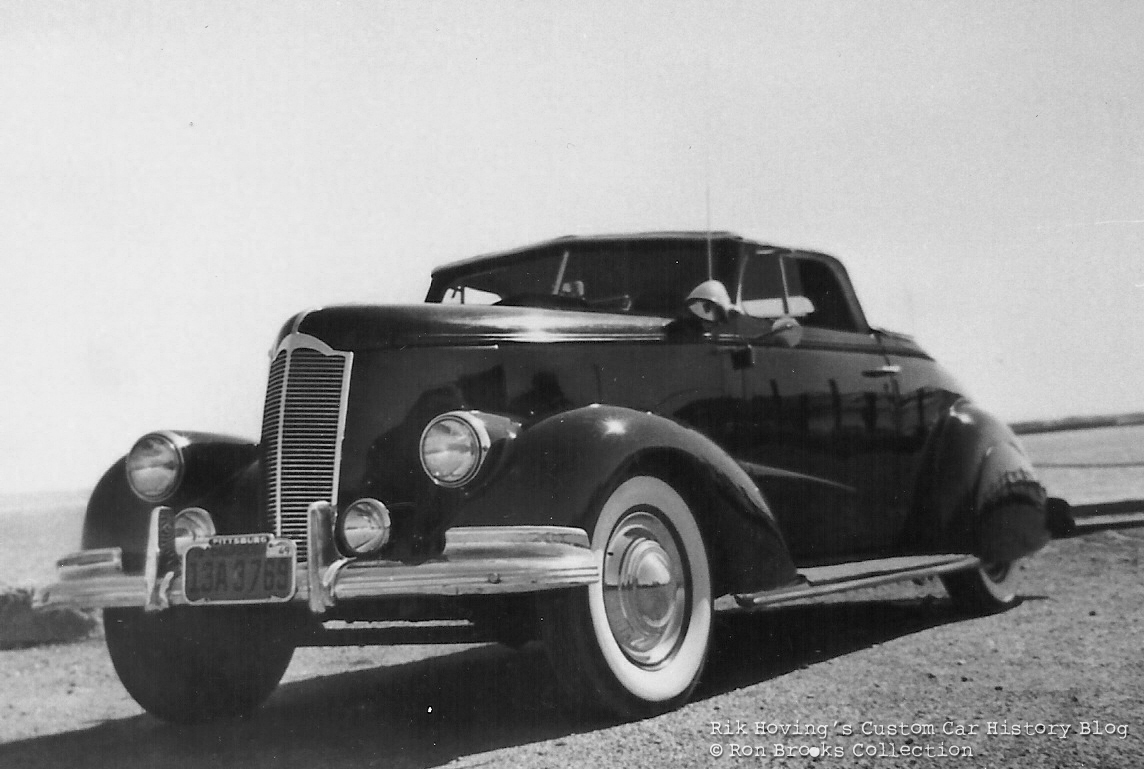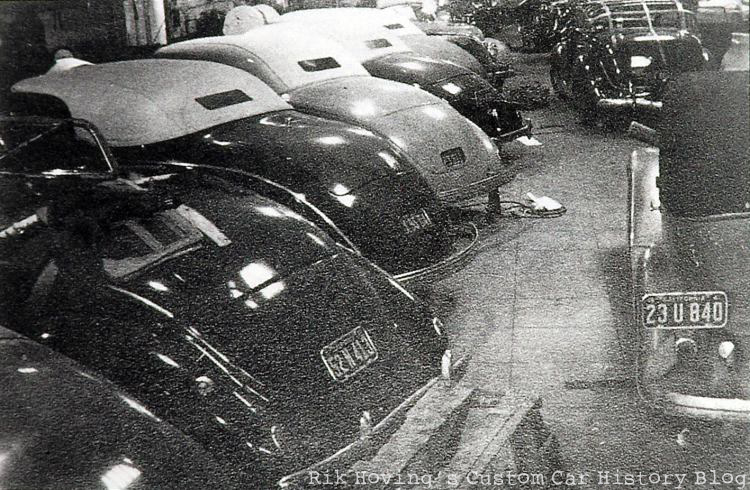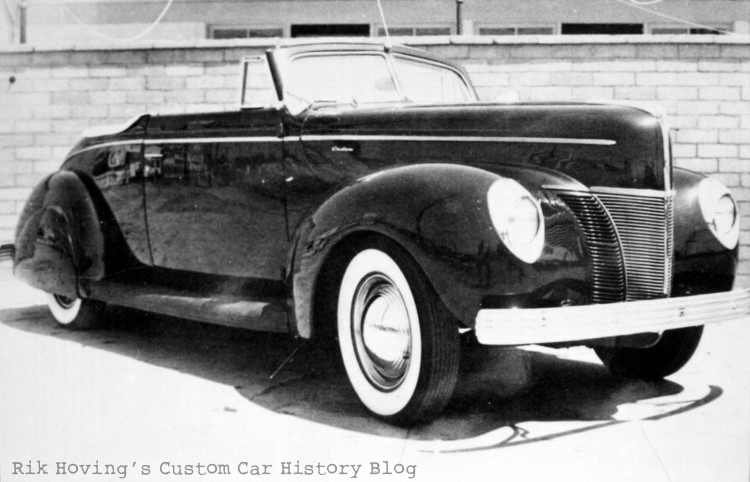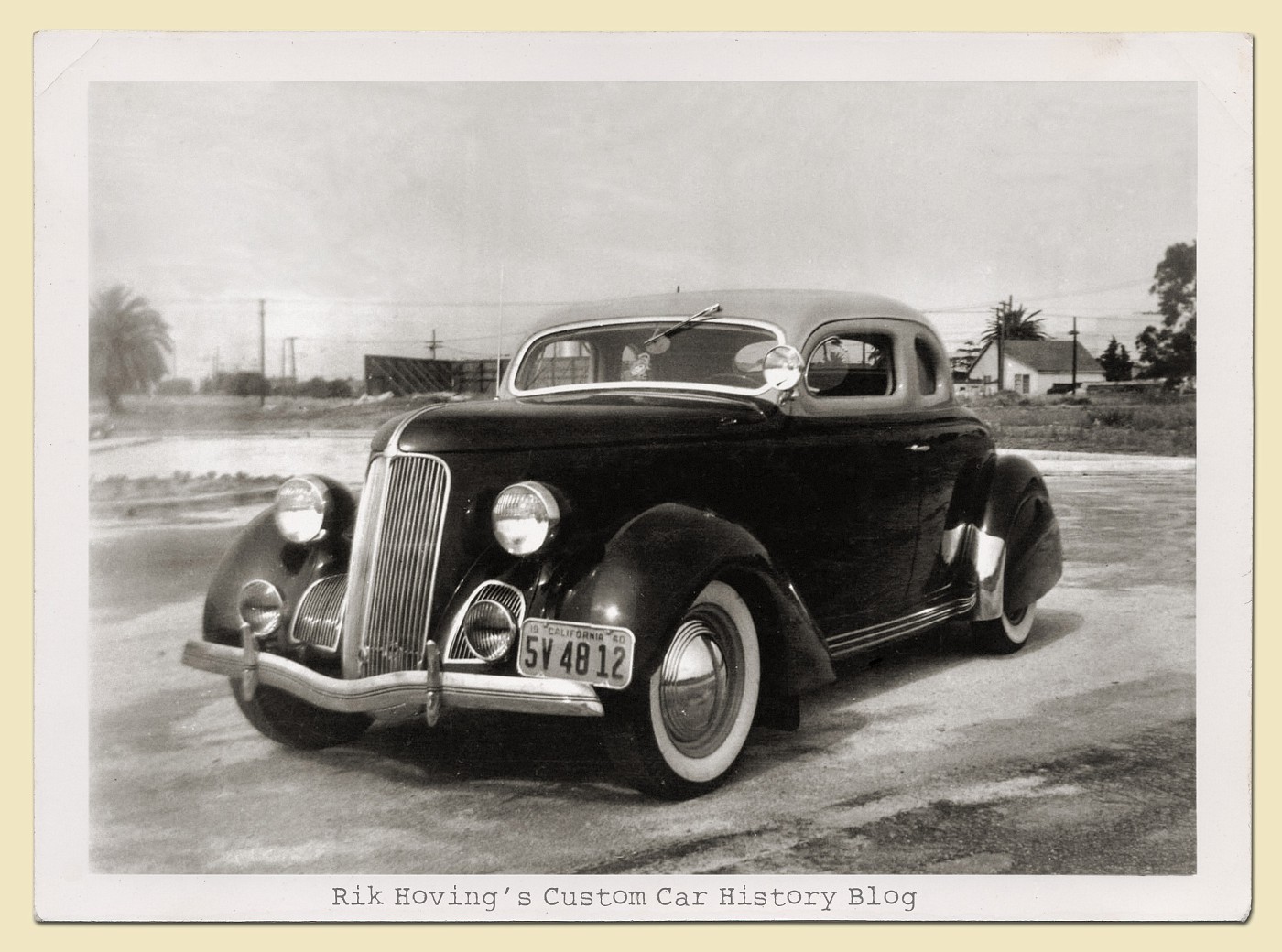I was 14 years old when I saw the first first "custom Car" in my life. It was during a vacation in Sweden with my parents. This was in the early 1980's. And most Custom Cars back then are now remembered for not being particular beautiful. But back then I loved every bit about them, and tried absorb as much info and as many photos I could find. Not really easy for a kid with no money on the wrong side of the world (the Netherlands). But over the years I managed to get a few US Custom Car magazines, and subscribed to a Swedish magazine that featured new and so every now and then some old Custom Cars. The Custom Cars style of the 1980's was so natural for me, and it took me some time to figure out most of them where inspired by the Custom Cars of the 1950's.
I then got really impressed with these wonderful styled Custom Cars from the 1950's and with some luck was able to find some unwanted 1950's Rod & Custom Magazines. And studied all these cars, from those magazines, the style they used, the details. Howe and by who they where built. I then started to believe Customizing really started in the early 1950's.
The more research I was able to do on the subject Custom Car, the more I noticed the cars built in the 1940's, built before WWII or right after it. The style of these early Custom Cars really appealed to me. They where pure, they where most of the time very stylish, glamourous and very tasteful. This style slowly disappeared in the late 1940's, although there are some samples of this style up into the early 1950's as well. The 1936 Ford 5-window coupe below was one of the first samples I saw of the early style Custom cars. There is a photo of it (deferent than the one below) in a book called Automobile and Culture.
Over the years I have wondered often why there is relatively limited interest in these early style Custom Cars. You rarely see recently built Custom Cars built in this early style. Sure there are some great samples, but the majority chooses the built new Custom Cars in the better known 50's style. Or for the last couple of years - in the satin paint, laying frame kind of styling.
When I post some photos of early built Custom Cars they rarely get many views, or comments on the Hamb. There are some exceptions, but in general you can say the 1950's styled Customs are favored by most.
 |
| Harry Westergard designed and built this 1938 Chevy Convertible for Sal Cociola. Packard grille, 1941 Oldsmobile bumpers. Aftermarket hubcaps, Spotlights, and the door handles left in place |
So what is it that makes these early style Customs
appeal to me so much?
These cars where all built in an era that Coach built cars where a "common" sight. Especially in California the rich and famous had special Coach built cars built for them. Wonderfully styled Custom creations which we don't call Custom Cars today. But these hand made one off Classic Cars where the inspiration for the boys in the street who wanted to make a statement, wanted to diverse them selfs from the crowd. They where not able to buy the Duesenberg's and Cadillac's that where used by the Coach Builder's. But they figured they would be able to get similar results when Customizing their everyday Fords, chevy's and Lincoln's - to name a few. Body shops in California started to do Customizing on cars, and soon the first custom shops where opened. Pioneers as Jimmy Summers, Frank Kurtis, George DuVall, Harry Westergard, Carson Top Shop and many others are responsible for a lot of these early Custom Cars, and the style that was developed for them. There where no magazines or Custom Car shows to promote the style. And still you saw Custom Cars pop up all around California. And most of them where very stylish. Body work was performed to create more exclusive looks for the car, and not just to be different as was the case in the 1950's.
A good sample of a mid 1940's styled Custom is the Lincoln Convertible below. A wonderful car to start with. But the customizer who designed and built this car knew exactly what to do and where to stop. The running boards where removed to create a more elegant body as seen on the most expensive Hand made Sports Cars from Europe. An elegantly shaped stainless steel rock guard was fabricated for the rear fender. This attracts the eye, and gives tome weight to the rear of the car. The door handles were left in place and give just the right amount of spark to the side of the car. The car was lowered, but just a small amount, and not put on a rake, just level, or perhaps with a slight rearward angle. The body work that was done was sharp, not with large amounts of lead as was so popular in the late 1940's and early 1950's. And then the perfectly styled padded top by Hall of Oakland. This all gives the car a very classic feel. I have often wondered if the early Custom builders might have been influenced by the wonderful and colorful artist impression illustration used in the early Car brochures. Many of those cars had the factory lines, but there drawn much lower than stock, had a visual chopped top, all made to make the car look longer and lower.
 |
| Photo from the Ron Brooks Collection. This photo was found hanging on the walls of the Hall of Oakland work shop. |
I think one of the key point for these early style Custom Cars is the balance between smooth crisp well designed body work, the right amount on chrome left or added to a car in combination with a perfect proportioned stance.
George DuVall and Frank Kurtis can be seen as pioneers in Custom Car building. They created some wonderful Custom designs on cars as old as 1929. The general point of view is that a car from 1936 and up can be called Custom Car. Everything older does not fit the category. But the samples below - early samples of customizing - sure can be seen and named as Custom Car in my book.
Lately there have been some discussions about 1933-34 Ford turned into Custom Cars, and some die-hard Hot Rodders will not go that way. But Pat Ganahl's excellent article on Wes Collin's 1934 Ford in Issue #51 of The Rodder's Journal has proven otherwise I think. Wes Collin's 1934 Ford Roadster is an early Custom car built in the early 1940's with all the style elements of the Coach-built cars, but based on a "cheap" Ford base. The car has been published before in early 1950's magazines and I have always wondered why nobody today would built a Custom based on this body style. (Rick Dore's 34 Ford convertible might be the only exception, but that was built as a modern street rod /custom)
When we discuss about the Art in early Custom Cars I have to show one of the high lights of them all. The So Calif. Plating Company Delivery Truck based on a 1935 Ford Phaeton. George DuVall designed the truck, and together with Frank Kurtis and Jimmy Summers the car was built at the end of 1935. The frame was stretched 12 inches, and so was the body just behind the front doors, the rear doors where welded shut. Brand new 1936 Ford fenders where added, because they looked so much better than the 35 units. The DuValle style windshield which is still a popular - mainly 32 Ford option - Hot Rod accessory today was designed for this car. And george also designed the wonderful grille. The whole car has a lot of chrome, but not to much, and what there is is either functional, or very well designed. Again all in style with what the major Coach builders where doing on high dollar cars in the mid/late 1930's. The wonderful long padded top designed by George DuVall and created by the George Thomas Top Shop is the icing on the cake. The top in combination with the very much laid back windshield create instant speed. The level stance with the large white walls and Custom hubcaps make you stare at this car for hours. Everything about it is perfect.
 |
| Spence Murray photo of the SoCal. Plating Delivery Truck. The car was painted sea foam green and can be seen here with the later added headlights. It used to run hidden woodlight headlights. |
A lot of the early Custom Cars are based on Convertible or Cabriolet body types. The good weather in California has a lot to do with this, but also the fact that most of the Coach Built cars from the 30's where based on these open cars. And the sleek body lines with a chopped windshield made and instant Custom Car. Top shops as the Carson Top Shop, Hall Of Oakland and others location in north and south california had a lot to do with the looks of these Early Custom Cars. The streamlined looks of the often white padded tops create an instant classic feel.
The fantastic often published photo of the Carson Top Shop shows the importance of these top shops. All these cars have this wonderful classic look. With wonderful flowing lines of the chopped padded tops.
 |
| Early 1940's photo taken at the Carson Top Shop. |
The 1940 Ford from Al Beckman could have been in the Carson Top SHop photo as well. The car has not much done to it, yet it is extremely attractive. Slightly lower than stock, with a chopped windshield. Appleton Spotlights Custom smooth hubcaps, fender skirts and 1937 DeSoto bumpers are the only customizing done to the car. What we cant see in this photo is the wonderful Tuck & Roll upholstery and Padded Top that Al had built for his car. The photo was taken in 1949, so the style was still very much accepted then.
 |
| Hal Peterson photo of Al Beckman's 1940 Ford - 1949 |
But in the later part of the 1940's things where changing Body shops where experimenting with adding parts from other cars brands. Custom made panels where created to make different body designs. Fenders where molded into the main body to create smoother - like melted butter - looking bodies.
Wonderful custom cars creations where created, but the simple crisp and classic style of the 1930's and early 1940's Custom Cars was slowly disappearing.
The sample below shows the early version of George Barris his 1941 Buick. The padded top is still there, but the addition of the smooth fade away front fenders, molded in panels and shaving of all the exterior chrome including the door handles give it a whole different look and feel than the other samples shown in this blog. I have to say I like both styles in customizing, but over the last couple of years I noticed than more and more photos of these early style Custom Cars have found their way on my office walls.
 |
| George Barris 1941 Buick. Photo taken in 1947-48 |





Cheers!
ReplyDeleteI am completely simpatico with your views concerning the genesis of the coach built/early custom car. I think that the average person, even going back to the late 1920's, would appreciate and find very compelling some of the custom bodied high end cars that they would see cruising the streets of Los Angeles and other large cities. It is particularly noteable in the case of Los Angeles because of the proximity of Hollywood, and the movie stars and other monied classes that could afford to have these custom bodied and tastefully altered cars made. The fact that the Fords, Mercurys, and other lower priced vehicles were done so well by these early customizers was a tribute to their vision and tastes. In summary, and in my personal opinion, the golden age of the custom car as we like to know it, spanned the era starting in 1935 and ending approximately 1953.
Very excited to see this new endeavor being launched!
"I have often wondered if the early Custom builders might have been influenced by the wonderful and colorful artist impression illustration used in the early Car brochures. Many of those cars had the factory lines, but they were drawn much lower than stock and had a visual chopped top, all made to make the car look longer and lower."
ReplyDeleteI think this is a very interesting thought.
Lars
The pale Collins/Mark Roadster is stunning, especially against that clean Los Angeles box and canyon embankment. Great photo.
ReplyDeleteWhen it comes to cars, every driver knows that details matter. From the exterior design to the performance under the hood, every aspect contributes to the driving experience. However, one feature that is often overlooked but plays a crucial role in both comfort and style is the steering wheel. At RCSCustom, we believe your steering wheel should be more than just a functional component; it should reflect your personality, enhance your control, and elevate your overall driving journey. That’s why we specialize in designing and crafting high-quality custom car steering wheels that transform the way you drive.
ReplyDeleteThe ART of early Custom Cars has always fascinated me. I was just 14 years old when I saw my very first "custom car" during a vacation in Sweden with my parents back in the early 1980s. Most Custom Cars from that era are now remembered for their quirky and sometimes unattractive styles, but at the time, I loved every detail. With little access to resources in the Netherlands, I collected US Custom Car magazines and even subscribed to a Swedish publication that showcased both new and old builds. That passion shaped my appreciation for automotive creativity, and it still inspires me today. And while enjoying the beauty of custom builds on the road, it’s equally important to rely on a dependable car tyre repair service whenever the unexpected happens.
ReplyDeleteWhen it comes to enhancing the driving experience, one component often overlooked is the steering wheel. It’s the part of the car you interact with most, yet many people accept the standard factory option without realizing the impact a steering wheel can have on comfort, style, and performance. For those who want a personalized touch, custom car steering wheels are the ultimate upgrade.
ReplyDeleteAt RCSCustom, we believe your steering wheel should reflect your driving style, personality, and attention to detail. But with so many options out there, one question often comes up: Who makes the best custom car steering wheels? Let’s explore what defines a great steering wheel, who benefits from customization, and why RCSCustom stands out as the answer.